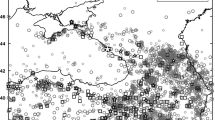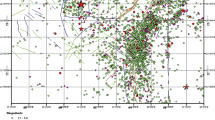An alternative methodology for probabilistic seismic hazard analysis (PSHA), is described. The approach combines the best features of the “deductive” (Cornell, 1968) and “historical” (Veneziano et al., 1984) procedures. The maximum regional magnitude m max is of paramount importance in this approach and the author present statistical technique that can be used for evaluation of this important parameter. The approach permits the utilization of incomplete and uncertain earthquake catalogues. The technique has been developed specifically for the estimation of seismic hazard at individual sites, without the subjective judgment involved in the definitions of seismic-source zones.
Access this chapter
Tax calculation will be finalised at checkout
Purchases are for personal use only
Preview
Unable to display preview. Download preview PDF.
Similar content being viewed by others
References
Ambraseys, N.N., Srbulov, M., 1994. Attenuation of earthquake-induced ground displacements. Earthquake Eng. Struct. Dyn. 23, 467–487.
Cornell, C.A., 1968. Engineering seismic risk analysis. Bull. Seism. Soc. Am. 58, 1583–1606.
Campbell, K.W., 1982. Bayesian analysis of extreme earthquake occurrences. Part I. Probabilistic hazard model, Bull. Seism. Soc. Am., 72, 1689–1705.
Gibowicz, S.J., Kijko, A., 1994. An Introduction to Mining Seismology. San Diego, CA: Academic.
Kijko, A., 1983. A modified form of the first Gumbel distribution: model for the occurrence of large earthquakes. Part II: Estimation of parameters. Acta Geophys. Pol., 31, 27–39.
Kijko, A., 2004. Estimation of the maximum earthquake magnitude mmax. Pure Appl. Geophys, 161, 1–27.
Kijko, A., Graham, G., 1998. “Parametric-Historic” procedure for probabilistic seismic hazard analysis. Part I: Assessment of maximum regional magnitude mmax. Pure Appl. Geophys.
Kijko, A., Sellevoll, M.A., 1992. Estimation of earthquake hazard parameters from incomplete data files, Part II, Incorporation of magnitude heterogeneity. Bull. Seism. Soc. Am. 82, 120–134.
McGuire, R.M., 1993. Computation of seismic hazard. Ann. Di Geofisica, 36, 181–200.
Tinti, S., Mulargia, F., 1985. Effects of magnitude uncertainties in the Gutenberg-Richter frequency-magnitude law. Bull. Seism. Soc. Am. 75, 1681–1697.
Veneziano, D., Cornell, C.A., O’Hara, T., 1984. Historic method for seismic hazard analysis. Elect. Power Res. Inst., Report, NP-3438, Palo Alto.
Author information
Authors and Affiliations
Editor information
Editors and Affiliations
Rights and permissions
Copyright information
© 2008 Springer Science + Business Media B.V
About this paper
Cite this paper
Kijko, A. (2008). Data Driven Probabilistic Seismic Hazard Assessment Procedure for Regions with Uncertain Seimogenic Zones. In: Husebye, E.S. (eds) Earthquake Monitoring and Seismic Hazard Mitigation in Balkan Countries. NATO Science Series: IV: Earth and Environmental Sciences, vol 81. Springer, Dordrecht. https://doi.org/10.1007/978-1-4020-6815-7_16
Download citation
DOI: https://doi.org/10.1007/978-1-4020-6815-7_16
Publisher Name: Springer, Dordrecht
Print ISBN: 978-1-4020-6813-3
Online ISBN: 978-1-4020-6815-7
eBook Packages: Earth and Environmental ScienceEarth and Environmental Science (R0)




